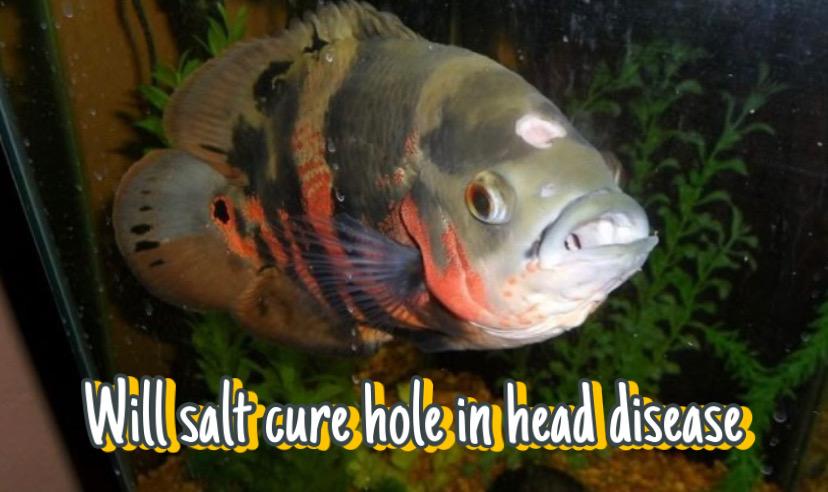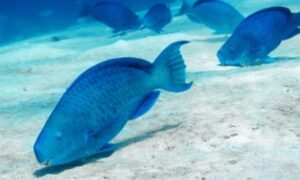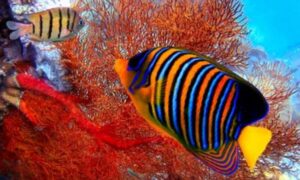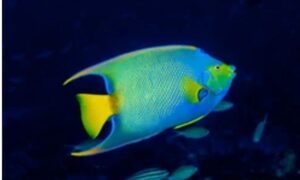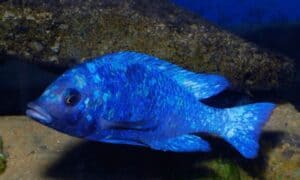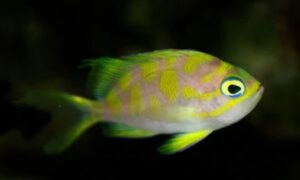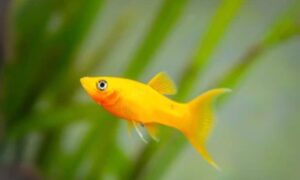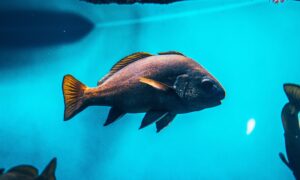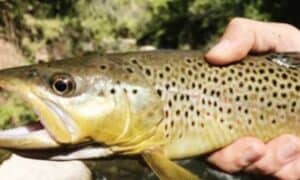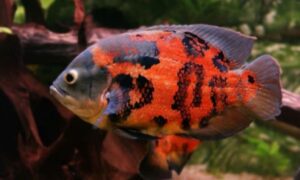Will Salt Cure Hole in Head Disease? Let’s find out in this article.
A hole in the head which is also known as lateral line erosion, or lateral line disease is a common problem that may affect many fish species.
Even though this disease is deadly to many fish, it is treatable by keeping your water clean and setting it at the right temperature in order to prevent secondary infections from occurring.
Some symptoms of the hole-in-head disease are the bulging eyes of fish, inflamed skin, and gaping holes in the head.
This disease can affect any freshwater fish and is actually one of the most common problems you will experience in your home aquariums or ponds.
Hole-in-head disease or Lateral Line Erosion may affect nearly 100% of fish. The main cause behind lateral line erosion is still not determined but there are many theories explaining it.
Table of Contents
What can cause hole-in-head disease?
Hexamita is a parasite and it is the most common cause of this disease. These parasites affect the intestine track of fish and they rapidly spread into the lateral line as well.
Secondary bacteria and other infections may occur along the lateral line as the disease increases.
The hole-in-head disease can occur due to different reasons, the most common cause is due to lateral line erosion, which takes place when fish rubs against hard surfaces. Another main reason behind this disease is that may be behavioral or environmental factors are affecting them like excessive scratching which is caused by external parasites.
Hole in head disease may also occur after severe drops in water temperature or sudden display to high temperatures, even if there is no physical trauma.
The Hole-in-head disease commonly takes place at times of high stocking density, overcrowding, and time periods of enormous feeding activity which is associated with mass medication campaigns. This disease can also occur in new fish which is introduced in your tank so the change of environment makes them under stress.
Another reason might be the activated carbon in filters, even though it’s good for improving the quality of water but it still might remove some important minerals and nutrients from your tank and a lack of minerals and nutrients can make your fish susceptible to disease.
Age factor can also be the reason behind this disease as with growing age the immune system of fish becomes weak and it can make your fish prone to disease.
These are some more factors that can cause a hole-in-the-head disease
- Parasites
- Poor water quality
- High-stress level
- Overcrowded tank
- Weak immune system
- Activated carbon present in filters
Is Hexamita infectious?
Not at all!! Hexamita will only spread to other fish if they are coming in direct contact with the fish that is infected. If you are keeping your fish in a cycled aquarium with strong and good filtration, then you should not be worried about the spread of Hexamita through your tank because it doesn’t survive without any infected fish.
If you want to add new fish to an already established tank, then you should quarantine the new fish for about two weeks or even longer before adding them to ensure safety and to prevent other fish from getting sick.
Hexamita is a type of parasite that has many forms. It is basically caused by an organelle which is called Oikomonas Hexamita that can be found in any fish, it appears more among aquarium fish.

Symptoms of Hexamita
The most common symptoms of Hexamita are weight loss and lethargy. There are also two other less obvious signs like Hole in the head disease and lateral line erosion. All these are related to parasite infection, especially Hexamita which basically infects freshwater catfish and carp.
When you observe your fish showing any signs of this disease, it is then crucial to treat them as soon as possible because Hexamita can cause serious damage or can kill your fish.
Early signs of a hole-in-head disease?
Infected fish may twitch its head swiftly and it may lose balance. It can also face difficulty in staying upright or moving in a forward direction due to seizures. The most obvious sign is that an infected fish can have an unsightly hole in its head.
If you find these holes around your fish’s face, they must be suffering from a hole-in-the-head disease. These holes will gradually get worse over time as bacteria will increase and multiply, so it is very important to treat your fish as soon as possible.
Before Lateral Line Erosion has occurred, an aquarist may observe small lumps on the head of their fish. These bumps will be quite pearly or fleshy depending on how much your fish is infected. These lumps are caused due to the infection of parasites inside the fish’s body.
How to treat hole-in-head Disease in Fish?
Hole in head disease is treatable, but it’s very hard to treat it using usual aquarium medications. Antibiotics can be used to treat external infections caused by bacteria, on the other hand lowering stress is also very important. These factors will keep the immune system of a fish healthy as well as make it calmer during its recovery time.
Stress is also going to lower the chances of a successful treatment for hole-in-head fish disease because stress lowers your fish’s energy and immunity making it much easier for you to transmit harmful infections to it.
Stress also plays an important role and can lower your chances of success with the treatment of this disease since stress lowers your fish’s energy levels and immunity making it much easier for transmitting infections.
Even though lateral line disease is difficult to treat, there are certain things you can easily do at home to help ease symptoms and cure the disease. You must change your aquarium water regularly and keeping it clean is a great initial step. You can also add 1-2 teaspoons of Epsom salt per 10 gallons of water in your aquarium.
You can also add a small amount of garlic or grapefruit juice to your home tank. Even though neither has been scientifically proven to treat this disease, you can try it as suggested by some aquarists.
Some other ways of treatments are copper sulfate, formalin, praziquantel, or salt. If you are using any medication, then it’s important to read product labels very carefully and must follow the dosage instructions. Also, observe whether your fish is stressed out, open sores on gills, and fins, skin lesions on the body, and holes near the base of fins or tail as these indicate how much your fish is suffering.
You must also maintain a balanced diet for your fish so their immune system becomes strong and they don’t get affected by this disease.
Ways to Treat Hole in the Head Disease
- Use Marine salt
- Maintain a balanced diet
- Water changes
- Ensure proper filtration system
Will Salt Cure Hole in Head Disease?
No!! Salt is not something that will completely cure hole in the head disease. Or you can’t completely rely on salt that it will remove the disease from fish. But it can still be used as a part of treatment as it contains the most important thing which is electrolytes which are known for improving fish’s overall health and can speed up the recovery process. But again salt is not something that can only be used for this disease.
Salt can help fish in getting rid of other diseases as well as a hole in the head disease. But it is not a cure for this hole-in-head disease though. This is because salt is not going to penetrate fish scales which is a layer of skin around each fish. Must use caution when adding salt in aquariums, because you don’t want to change your fish’s water too often, or exposing them to large amounts of salt for extended periods of time is quite harmful. It is ideal to add small doses during the process of treatment.
Risk of adding salt to the Fish Tank
If you add too much salt or you add salt to the tank on regular basis then it’s very dangerous for your fish. The high salt concentration is very dangerous and can harm your fish and it’s more dangerous for those species that don’t have any scales since they have less protection against the penetration of salt.
Also, make sure that you are not altering the salinity of your tank to those levels which can be harmful to your fish. As your fish might even die in the process of you treating them with salt!!
So in short maintain the salinity of your tank and don’t add too much salt in your tank to avoid any disappointment.
Which Salt can we use for treating this disease?
You are not supposed to add any salt you have in your tank. Not all salts are for fish tanks!!
You must only use special aquarium salts and never ever use table salt that you have at home to cure this disease.
You must not use salt which has iodine or anticaking agents as they can be very dangerous for your fish.
You can purchase aquarium salt from local pet shops. But also with aquarium salt you have to be careful and add only a small quantity of it to the tank
For curing holes in the head disease, you must use kosher salt.
Methods of Salt Treatment for Hole in the Head Disease
The first step is to quarantine the affected fish so the sick fish doesn’t transmit its disease to other fish. The next step is to add one tablespoon of aquarium salt to 5-10 gallons of water.
I suggest you add only a bit of salt at first and then measure the salinity of your tank so it doesn’t reach extreme levels.
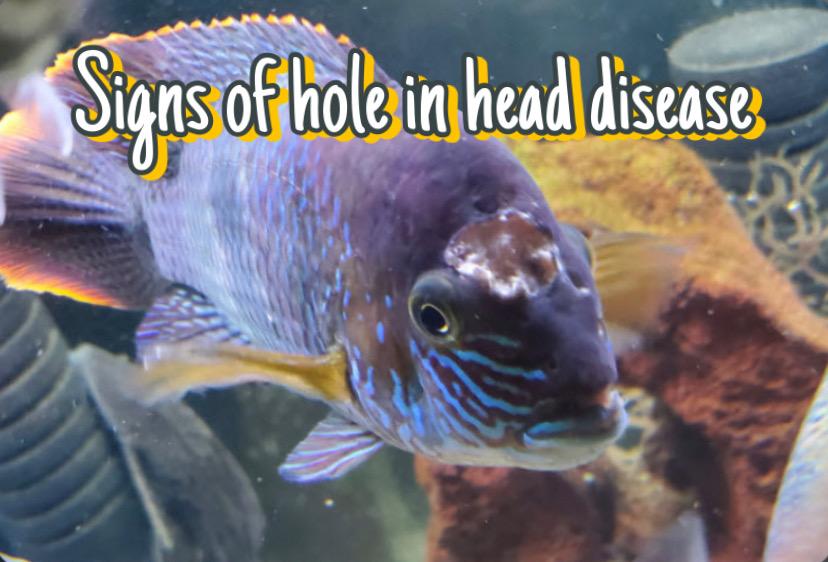
Is the hole in the head disease recoverable?
Yes, it definitely is!! Fish can recover from hole-in-the-head disease as long as it’s diagnosed on time and is taken care of properly by a veterinarian and treated at an early stage. These are some steps you must follow to help your fish get better from hole-in-head disease:
- Check with the veterinarian if your fish has a hole-in-head infection
- Quarantine or isolate infected fish in a separate tank to avoid spreading the disease to other healthy fish in your tank.
- Remove carbon filters from your tank. Carbon filters can absorb certain medications that can be risky for your fish.
- Purchase an ultraviolet light (UV) filter for the treatment of diseases like holes in the head. UV treatments require three to five days which depends on water temperature, but they are typically harmless and don’t leave any residue in water after the process of treatment.
- Water changes are also a great way of reducing the stress placed on fish during the process of treatment.
How to prevent a hole in Head Disease?
This disease can be prevented by improving the quality of water by keeping the water clean and also keeping the tank clean. You must use quarantine tanks for new fish before introducing them to developed tanks, and practice good netting techniques to prevent transferring parasites and disease between bodies of water.
When you bring a wild-caught fish into an aquarium, it is already exposed to many of these harmful diseases, and curing them can literally be impossible; once a fish starts showing symptoms of a hole-in-head disease or any other disease, treat it as soon as possible before it spreads to other healthy fishes of your aquarium.
For preventing hole in the head disease you must follow these
- If your fish gets infected, immediately shift it to a quarantine tank
- Change aquarium water on a daily basis
- Must ensure they are having a proper diet
- Make sure your fish doesn’t get stressed out
- Ensure that the filtration system is good
- Try to protect your fish from parasites
Conclusion
Hole in the head disease, also known as lateral line erosion, is a common problem that may affect many freshwater fish species. While the main cause behind lateral line erosion is still not determined, the most common cause is the Hexamita parasite. Secondary bacterial and other infections may occur along the lateral line as the disease progresses. This disease may be caused by several factors such as poor water quality, high-stress levels, overcrowded tanks, and weak immune systems.
Although it is treatable by keeping the water clean, antibiotics can be used to treat external infections caused by bacteria, and Epsom salt can be added to help ease symptoms and cure the disease. It is essential to treat your fish as soon as possible as the disease can cause serious damage or even kill your fish. Regular water changes, keeping the tank clean, and reducing stress levels can help prevent hole-in-the-head disease in your fish.
To read more about salt curing holes. And to read about fish and how to care for and breed them do visit our website fishcaringnow.com!!!

